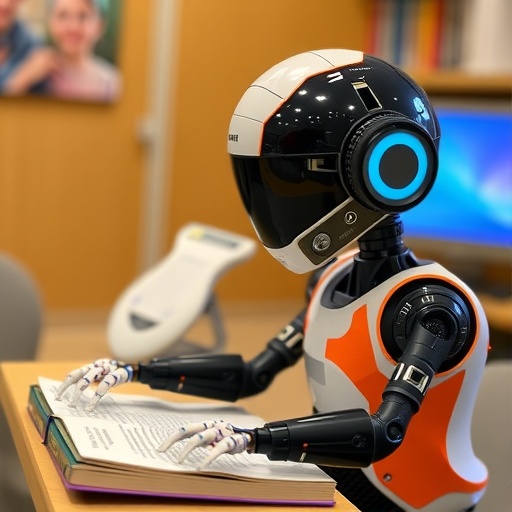In recent years, the educational landscape has witnessed a significant evolution in how computational thinking is integrated into early childhood education. A pioneering study led by researchers Esther-del-Moral-Pérez, López-Bouzas, and Castañeda-Fernández highlights the innovative use of game-based storytelling through a robot character to engage young learners. This approach not only makes learning enjoyable but also fosters essential skills that will benefit children in an increasingly digital world.
At the heart of this research lies the assertion that storytelling can act as a powerful medium to introduce complex concepts to young minds. The integration of a robotic character in the narrative creates a stimulating environment that encourages children to participate actively in their learning processes. By embedding computational thinking within engaging stories, educators can cultivate an early interest in technology and problem-solving, which are critical skills in the 21st century.
The concept of computational thinking is often discussed in educational settings, yet its application in early childhood education has not been sufficiently explored until now. Computational thinking involves a series of cognitive skills that enable individuals to tackle complex problems methodically. Through the use of engaging narratives and characters, young children can discover the joy of thinking critically and creatively while navigating through various challenges presented in the story.
One of the standout features of the robot character in this study is its ability to interact with children in real-time, providing immediate feedback and responses. This dynamic interaction captivates young learners and enhances their engagement level, making them more inclined to experiment and explore different solutions. The researchers found that children were more motivated to participate when an entertaining robot guided them through various storytelling elements.
Moreover, gamification plays a crucial role in this educational framework. By transforming traditional storytelling into an interactive game, children are more likely to grasp complex ideas without the stress associated with conventional learning methods. Through assessments and observations during the study, the researchers noted that children displayed higher levels of retention and understanding of computational thinking concepts when these ideas were presented in a game format.
The impact of this robot-enhanced storytelling approach extends beyond mere academic performance. It promotes social interaction among peers, as children often work together to solve problems posed by the robot character. This collaborative effort cultivates essential social skills, including teamwork and communication, which are vital for their overall development. Encouraging collaborative problem-solving through storytelling fosters a sense of community among young learners, enhancing their interpersonal skills.
Furthermore, the study revealed that integrating digital technology into storytelling can bridge the gap between modern childhood experiences and traditional educational practices. In an era where children are often exposed to technology from a young age, utilizing devices such as robots in classrooms allows educators to create content that resonates with their experiences. This coherence between children’s everyday interactions with technology and their educational activities fosters a seamless learning environment.
As society continues to evolve in its technological capabilities, the urgency for educational institutions to keep pace cannot be understated. The research spearheaded by Esther-del-Moral-Pérez and her colleagues serves as a beacon for educators seeking innovative methods to incorporate computational thinking into their curricula. By embracing groundbreaking approaches like game-based storytelling with robotic characters, educators can effectively spark a passion for learning and innovation in young children.
The findings from this significant study provide a clear rationale for educational policy changes. By promoting technology-rich environments in early learning settings, policymakers can help prepare young learners for future challenges in a tech-driven society. The evidence gathered through this research could potentially influence curriculum design at various educational levels, advocating for a stronger emphasis on computational thinking in early childhood education frameworks.
In addition, the methodologies employed in this study pave the way for future research endeavors. As educators and researchers delve deeper into the intersection of play, storytelling, and technology, subsequent studies can explore various factors that contribute to the efficacy of these approaches. Identifying best practices and honing techniques for storytelling with robotic characters can lead to even greater educational breakthroughs.
The implications of this research reach far beyond the classroom setting. As young children engage in computational thinking activities, they begin to see themselves as creators and innovators, rather than passive consumers of information. This shift in perspective can profoundly impact their future learning trajectories, motivating them to pursue careers in fields such as science, technology, engineering, and mathematics (STEM)—areas that are increasingly critical to global development.
In summary, the groundbreaking research conducted by Esther-del-Moral-Pérez, López-Bouzas, and Castañeda-Fernández presents a compelling case for the integration of game-based storytelling with robotic characters in early childhood education. By activating computational thinking skills in a fun and engaging manner, this innovative approach prepares young learners not just academically, but also socially and emotionally for a complex world. As educators look to the future, harnessing the power of technology in storytelling will undoubtedly become a cornerstone of effective teaching strategies.
The value of this research cannot be emphasized enough. It heralds a new era in educational practices where technology coexists harmoniously with traditional learning methodologies. The lessons learned from this study point toward a future where educators and researchers can collaboratively design curricula that inspire curiosity and ignite creativity in young learners, ultimately shaping a generation of innovative thinkers poised to tackle the challenges of tomorrow.
Subject of Research: The use of game-based storytelling with a robot character to enhance computational thinking in young children.
Article Title: Game-Based Storytelling with a Robot Character: Activating Computational Thinking in Young Children.
Article References:
Esther-del-Moral-Pérez, M., López-Bouzas, N. & Castañeda-Fernández, J. Game-Based Storytelling with a Robot Character: Activating Computational Thinking in Young Children. Early Childhood Educ J (2025). https://doi.org/10.1007/s10643-025-01930-x
Image Credits: AI Generated
DOI:
Keywords: Computational thinking, early childhood education, game-based learning, storytelling, robotics, interactive learning.




